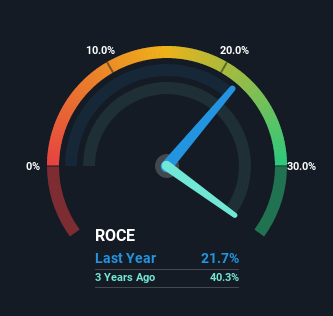- United States
- /
- Consumer Durables
- /
- NasdaqGS:CRCT
Returns On Capital Signal Tricky Times Ahead For Cricut (NASDAQ:CRCT)

What are the early trends we should look for to identify a stock that could multiply in value over the long term? Firstly, we'll want to see a proven return on capital employed (ROCE) that is increasing, and secondly, an expanding base of capital employed. Basically this means that a company has profitable initiatives that it can continue to reinvest in, which is a trait of a compounding machine. Looking at Cricut (NASDAQ:CRCT), it does have a high ROCE right now, but lets see how returns are trending.
Understanding Return On Capital Employed (ROCE)
If you haven't worked with ROCE before, it measures the 'return' (pre-tax profit) a company generates from capital employed in its business. Analysts use this formula to calculate it for Cricut:
Return on Capital Employed = Earnings Before Interest and Tax (EBIT) ÷ (Total Assets - Current Liabilities)
0.22 = US$159m ÷ (US$966m - US$233m) (Based on the trailing twelve months to March 2022).
Therefore, Cricut has an ROCE of 22%. In absolute terms that's a great return and it's even better than the Consumer Durables industry average of 16%.
See our latest analysis for Cricut

In the above chart we have measured Cricut's prior ROCE against its prior performance, but the future is arguably more important. If you'd like, you can check out the forecasts from the analysts covering Cricut here for free.
What Does the ROCE Trend For Cricut Tell Us?
On the surface, the trend of ROCE at Cricut doesn't inspire confidence. Historically returns on capital were even higher at 40%, but they have dropped over the last three years. However it looks like Cricut might be reinvesting for long term growth because while capital employed has increased, the company's sales haven't changed much in the last 12 months. It may take some time before the company starts to see any change in earnings from these investments.
On a side note, Cricut has done well to pay down its current liabilities to 24% of total assets. That could partly explain why the ROCE has dropped. What's more, this can reduce some aspects of risk to the business because now the company's suppliers or short-term creditors are funding less of its operations. Since the business is basically funding more of its operations with it's own money, you could argue this has made the business less efficient at generating ROCE.
Our Take On Cricut's ROCE
To conclude, we've found that Cricut is reinvesting in the business, but returns have been falling. And investors may be expecting the fundamentals to get a lot worse because the stock has crashed 80% over the last year. In any case, the stock doesn't have these traits of a multi-bagger discussed above, so if that's what you're looking for, we think you'd have more luck elsewhere.
Since virtually every company faces some risks, it's worth knowing what they are, and we've spotted 4 warning signs for Cricut (of which 1 is significant!) that you should know about.
Cricut is not the only stock earning high returns. If you'd like to see more, check out our free list of companies earning high returns on equity with solid fundamentals.
New: AI Stock Screener & Alerts
Our new AI Stock Screener scans the market every day to uncover opportunities.
• Dividend Powerhouses (3%+ Yield)
• Undervalued Small Caps with Insider Buying
• High growth Tech and AI Companies
Or build your own from over 50 metrics.
Have feedback on this article? Concerned about the content? Get in touch with us directly. Alternatively, email editorial-team (at) simplywallst.com.
This article by Simply Wall St is general in nature. We provide commentary based on historical data and analyst forecasts only using an unbiased methodology and our articles are not intended to be financial advice. It does not constitute a recommendation to buy or sell any stock, and does not take account of your objectives, or your financial situation. We aim to bring you long-term focused analysis driven by fundamental data. Note that our analysis may not factor in the latest price-sensitive company announcements or qualitative material. Simply Wall St has no position in any stocks mentioned.
About NasdaqGS:CRCT
Cricut
Engages in the design, marketing, and distribution of a creativity platform that enables users to turn ideas into professional-looking handmade goods.
Flawless balance sheet with proven track record.
Similar Companies
Market Insights
Community Narratives




